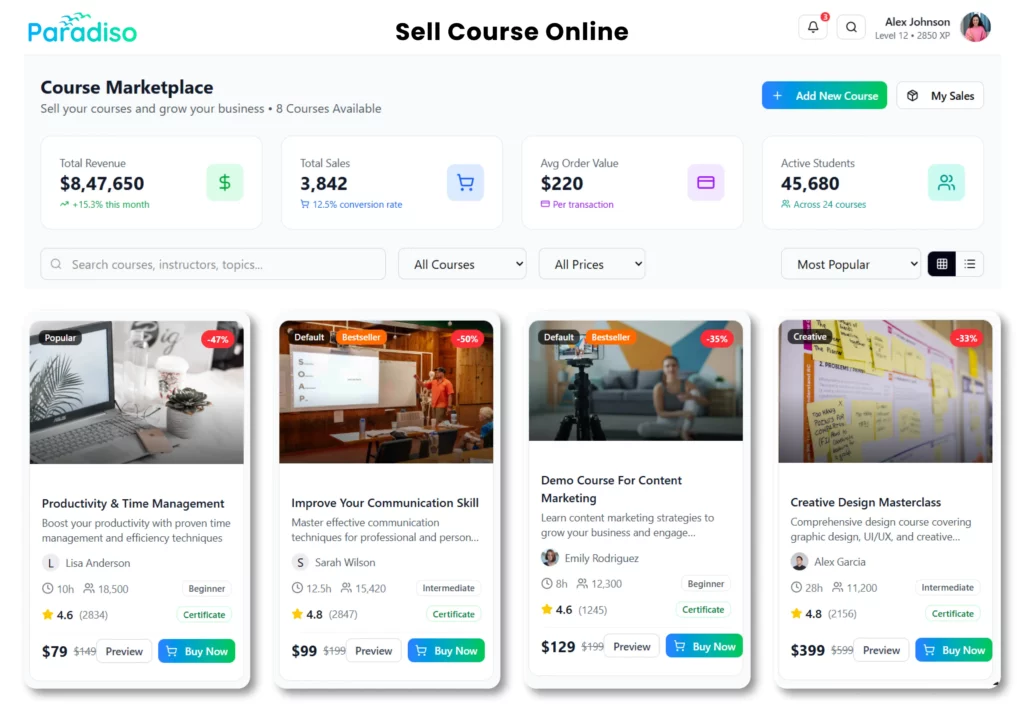In today’s digital era, eLearning has revolutionized the education and training landscape, providing learners with flexible and accessible opportunities to acquire knowledge and skills. At the heart of this revolution lies eLearning platforms, powerful tools that facilitate online learning experiences. In this blog, we will delve into the concept of eLearning platforms, explore their benefits, discuss different types, and provide guidance on choosing the perfect platform for your specific needs.
What is eLearning Platform ?
eLearning platforms are online systems designed to deliver educational content, courses, and training materials to learners through digital means. They act as virtual learning environments, creating a structured and interactive space for learners to access course materials, engage in activities, communicate with instructors or peers, and track their progress. These platforms leverage various technologies such as Learning Management Systems (LMS), multimedia resources, and communication tools to facilitate an engaging and effective learning experience.
Benefits of using eLearning platform
a) Flexibility and Accessibility:
eLearning platforms break the barriers of time and location, allowing learners to access educational content from anywhere and at any time. This flexibility enables individuals to learn independently, accommodating diverse schedules and learning styles.
b) Engaging and Interactive Learning:
eLearning platforms often incorporate multimedia elements, such as videos, interactive quizzes, simulations, and gamification, to enhance learner engagement and interactivity. These features promote active learning and retention of knowledge.
c) Personalized Learning Paths:
Many eLearning platforms offer personalized learning paths, tailoring the content and pace to each individual’s needs and abilities. Learners can progress through the material based on existing knowledge, ensuring a customized and efficient learning experience.
d) Cost-Effectiveness:
eLearning platforms eliminate the need for physical infrastructure and reduce travel expenses, making education and training more cost-effective for individuals and organizations. Additionally, economies of scale can be achieved by simultaneously delivering training to many learners.
Types of eLearning Platforms
a) Learning Management Systems (LMS):
LMS platforms are a centralized hub for organizing and managing learning content, tracking learner progress, and facilitating communication between learners and instructors. They are commonly used in academic institutions and corporate training settings.
b) Massive Open Online Courses (MOOCs):
MOOC platforms offer access to courses from various educational institutions and instructors. They often provide interactive discussion forums, peer assessments, and certificates upon course completion.
c) Online Course Marketplaces:
These platforms feature a marketplace-style approach, hosting courses from multiple instructors or organizations. Learners can browse the course catalogue and select the ones that align with their interests and goals.
d) Virtual Classroom Platforms:
Virtual classroom platforms enable real-time, interactive online learning experiences through features like video conferencing, screen sharing, and collaborative tools. They are particularly useful for live lectures, webinars, and remote training sessions.
4 Steps to Choosing the Best eLearning Platforms
a) Identify Your Needs:
Assess your specific learning requirements, whether you are an individual seeking personal development or an organization looking for employee training. Consider factors such as content type, desired features, scalability, and integration capabilities.
b) Evaluate Features:
Look for essential features like content authoring tools, assessment options, reporting and analytics, mobile compatibility, and learner collaboration features. Ensure the platform aligns with your desired learning objectives and instructional strategies.
c) User Experience:
Consider the platform’s user interface, ease of navigation, and overall user experience. A well-designed and intuitive interface contributes to a seamless learning journey.
d) Support and Training:
Determine the level of technical support, training resources, and customer service the platform provides. Responsive support is crucial for resolving any issues arising during the learning process.
Conclusion:
eLearning platforms have revolutionized how we acquire knowledge and skills, providing a flexible, interactive, and personalized learning experience. By understanding the concept, benefits, and types of eLearning platforms and following the guidelines for choosing the right one, learners and organizations can unlock the full potential of online education and training. Embrace the power of eLearning platforms, and embark on lifelong learning and growth.
Choosing the right eLearning platform is a critical decision that can significantly impact learning outcomes. While several excellent options are available, Paradiso LMS stands out as a frontrunner due to its feature-rich nature, user-friendly interface, exceptional support, and scalability. Consider Paradiso LMS as your trusted partner on your eLearning journey, and unlock the full potential of online education and training.
Remember, the right eLearning platform can be a gateway to a world of endless possibilities!













